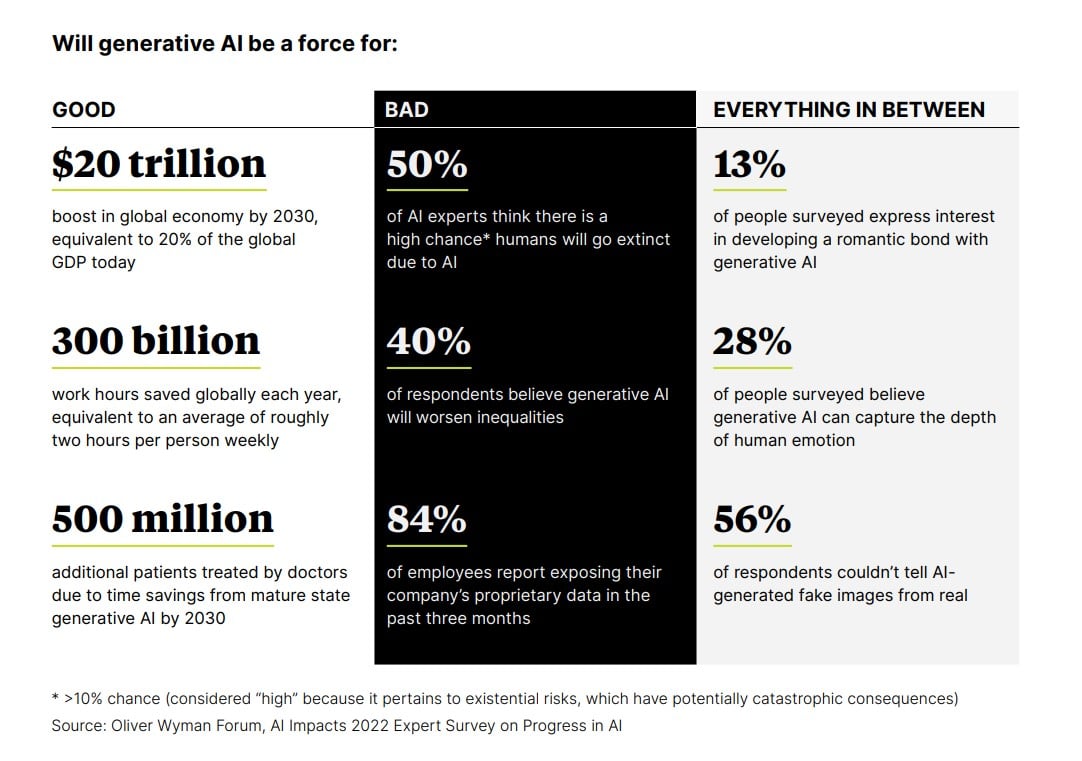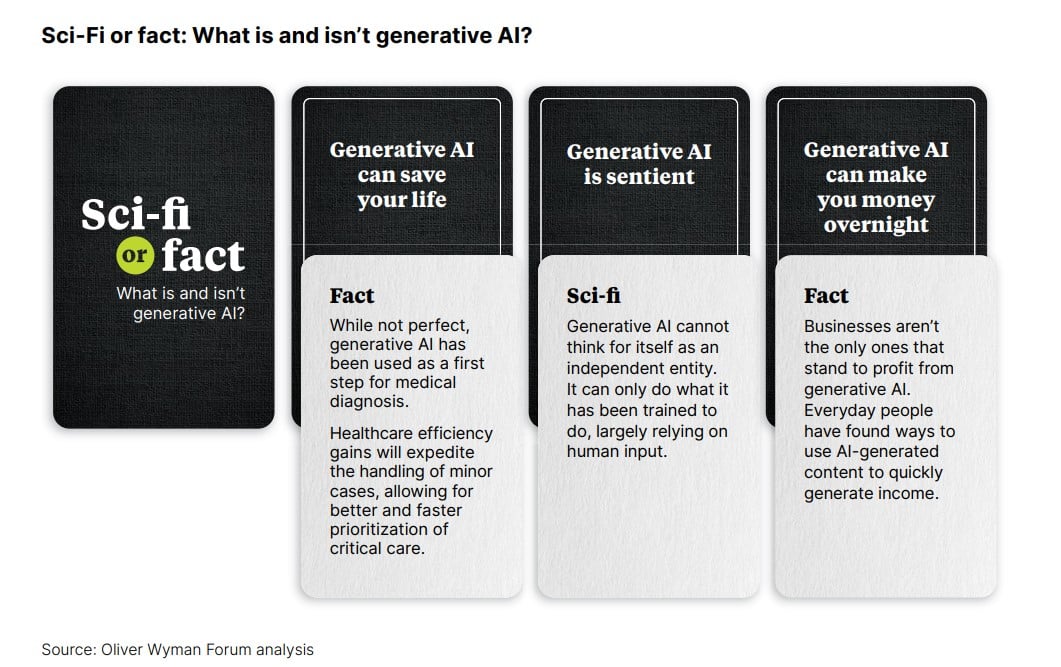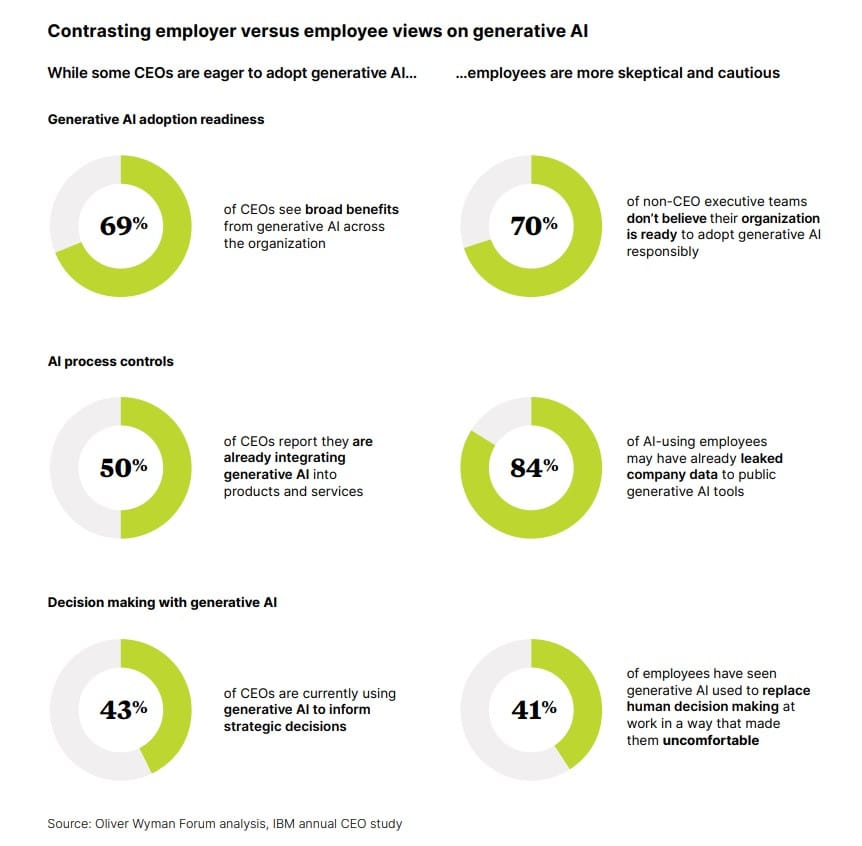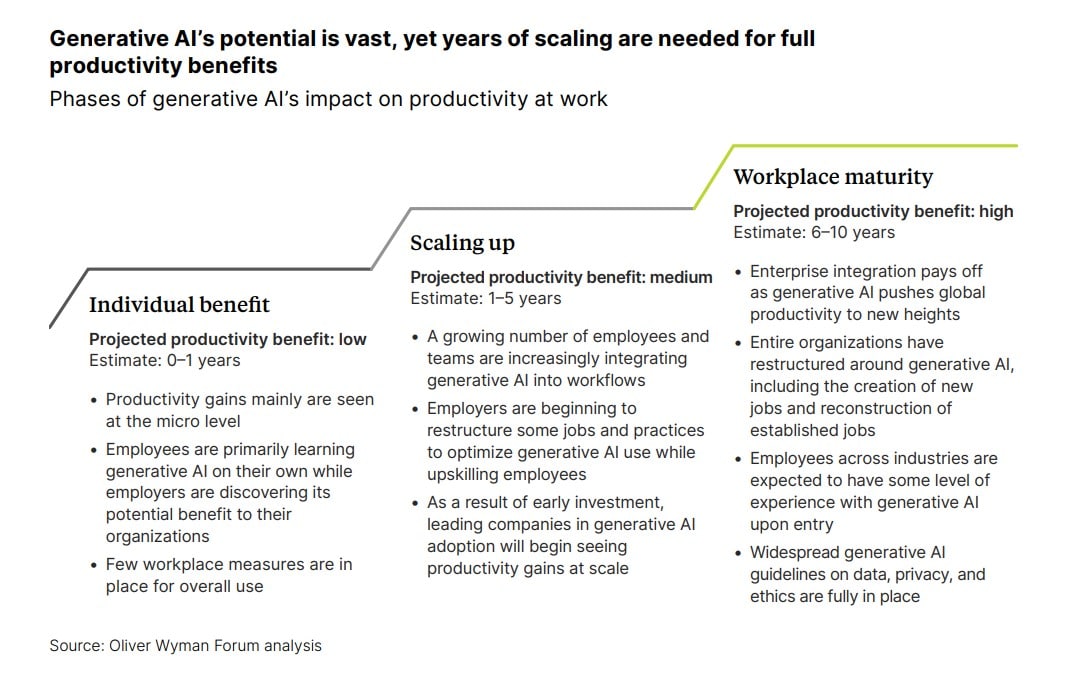Business leaders were foaming at the mouth just a few months ago when AI’s promise of uber-productivity was dangled in front of them. And some of the earliest adopters have even seen the promise becoming reality in the meantime. But new research from management consulting firm Oliver Wyman asserts that these companies are the exceptions, not the rule, and the vast majority of businesses are years away from seeing real results.
The firm’s new report, How Generative AI is Transforming Business and Society—released earlier this month at the World Economic Forum Annual Meeting in Davos, and produced by the company’s think tank, the Oliver Wyman Forum—found that more than half of employees globally now use generative AI at work and that adoption is far higher in some countries. But the Forum also found that adoption has not necessarily translated into higher levels of productivity—yet.

“The adoption rate of generative AI has been nothing short of remarkable,” said John Romeo, CEO of the Oliver Wyman Forum, in a news release. “ChatGPT achieved mass adoption in less than one year—a stark contrast to the internet, which took 17 years, smartphones 21 years, and electricity which took three decades—but training is not keeping up and we are facing an AI productivity disconnect.”
Forecasting business impact over the next decade, the report shows generative AI-trained junior employees will climb into management ranks faster than ever before. And senior-level leaders express the greatest concerns about losing their jobs to generative AI automation. But if there’s one actionable takeaway from the research, it’s that taking a “wait and see” approach is ill-advised—get ahead of the game now, or get left further behind when the payoff starts to materialize in the mainstream.

Key workplace findings from the report:
The most explosive growth has been among pink- and blue-collar workers
Between June and November 2023, generative AI use exploded among white-collar knowledge workers as well as pink-collar workers. Doctors, nurses, and life-sciences employees increased weekly use by 264 percent. Weekly adoption among pink-collar education employees grew 144 percent, and blue-collar retail worker use increased by 71 percent.
Productivity gains are still likely years away
As many as 20 percent of employees who report generative AI has not increased their productivity say they are bogged down by corporate guidelines and “unsatisfactory output” which adds review and editing time to projects. The full potential of generative AI’s productivity gains is still six to 10 years away, according to the report.
There’s an extensive generative AI training gap
Lack of productivity may be linked to insufficient training. Employees at all levels seek more upskilling than employers currently provide. Among white-collar employees, 80 percent want more or better AI training, but only 64 percent currently say they receive it. This gap is wider among pink-collar employees.
Job loss concerns remain prevalent
Across the 17 industries and job types studied, 60 percent of employees express increasing concern their jobs will be replaced by generative AI. Globally, 30 percent of all job seekers say generative AI is motivating their job search. Employees who worry about AI are 57 percent more likely to feel their productivity is declining and 78 percent more likely to believe they don’t matter to their employer, according to recent data from the American Psychological Association.
Developing countries are ahead
India leads 16 countries in employee adoption with 83 percent surveyed reporting daily or at least weekly use of generative AI. By contrast, weekly use by North American and European employees is below 50 percent.

Consumer findings include:
Bias concerns are widely felt
In all 16 countries studied, most consumers are concerned generative AI is producing biased content. People are most concerned in India (92 percent) and least concerned in France (73 percent), while 83 percent of US respondents report being concerned.
Trust remains a major obstacle
When asked if organizations using generative AI are untrustworthy, 29 percent said “yes,” with 18 percent saying generative AI tools “are not trustworthy at all” or “not very trustworthy.”
There’s also privacy, cybersecurity and more
Privacy, cybersecurity and overreliance on generative AI are the top three concerns for over 30 percent of consumers, but many cited additional worries, including job loss (29 percent), environmental impact (15 percent) and mental health (14 percent).

“Automation is no longer just a narrative of blue-collar workers. Many white-collar workers fear their roles will become displaced with generative AI, and this anxiety is having a direct impact on productivity,” said Ana Kreacic, COO of the Oliver Wyman Forum and chief knowledge officer of the Oliver Wyman Group, in the release. “It’s a misconception for businesses to wait a year or two and hope to hire a fully generative AI trained workforce. Companies need to reskill the employees they have now by focusing on areas with the most near-term applications.”
Download the full report here.
The Oliver Wyman Forum conducted the survey to enhance its understanding of generative AI, specifically in the context of the workplace, the consumer economy, and risk. The survey was conducted in June and November 2023 among a total of 25,000 respondents across 16 countries including: the United States, Canada, Mexico, Brazil, the United Kingdom, France, Italy, Germany, Spain, China (Hong Kong), India, Indonesia, Singapore, the United Arab Emirates, and Australia.




